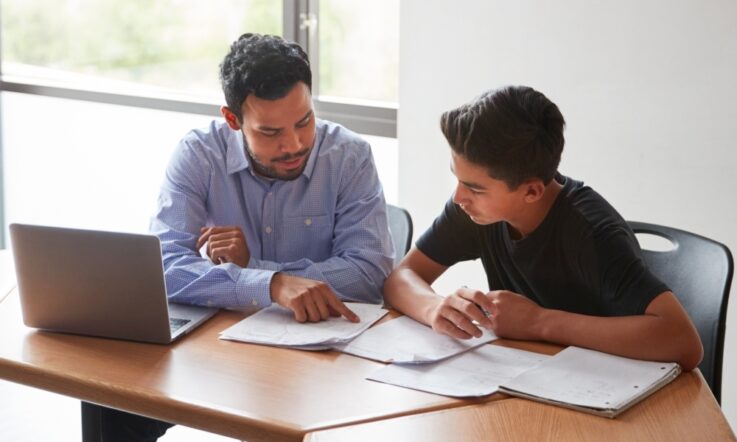Throughout the 2020 school year, students in Australia and across the world faced disruptions to their learning as they moved to remote learning due to the COVID-19 pandemic.
Small group tutoring has emerged as a strategy to support those students who’ve fallen behind, with governments pledging support for initiatives in their states and territories.
Late last year, the Victorian Government pledged $250 million for 4100 tutors to be deployed in Victorian schools. New South Wales announced a similar program worth $337 million, employing 5500 tutors to helping struggling students. In South Australia, up to 2000 public school students will have access to one-on-one maths tutoring as part of a $3.6 million pilot that will see qualified teachers deliver tutoring to students.
In these programs, tutors will work across primary, secondary and specialist settings – starting from the beginning of the 2021 school year.
School leaders are experts of their own contexts and communities, and they know best which model of small group support is appropriate for their students’ learning, engagement and wellbeing needs, and their staffing arrangements. Therefore, the role of school leaders is crucial in co-designing tutoring programs for their own context.
Karen Money is principal of Melbourne Girls’ College in Victoria, and in 2021, she’s been seconded to lead the Victorian Department of Education and Training’s Tutor Learning Initiative.
Money says schools are very diverse places, and the Victorian Government isn’t going to be able to apply a one-size-fits-all approach to designing the tutoring model that best suits each individual school.
‘A central system isn’t going to be able to design the very best model or really identify, most importantly, the young people that need the support. That’s why we need to co-design it with the profession. We need to trust that our principals and our schools have already started identifying the young people that didn’t engage during remote and flexible learning. We trust that they already have assessment schedules where they are benchmarking and then book-ending learning growth, or lack of learning growth, to help them identify the students.’
Julie Sonnemann is Acting School Education Program Director at the Grattan Institute. In June 2020, she co-authored a report that found a large cohort of disadvantaged students — especially those from the poorest families, with learning difficulties, or where languages other than English are spoken at home — will have fallen much further behind than their classmates during the school closures.
Her analysis also shows disadvantaged students in Victoria are likely to have lost between two and six months of learning over the remote schooling period. The equity gap between advantaged and disadvantaged students grew at triple the rate during that same period.
Sonnemann says that co-design is a really good way to ensure that the model works for those it’s intended for.
‘That doesn’t mean that the model in schools is a “free-for-all” or it’s unstructured,’ Sonnemann tells Teacher. ‘Co-design simply means that you come up with a range of things that best suits schools, in line with the evidence of what might work in their particular context.’
How to determine which students need support
Research shows that small group tutoring is a highly effective remedial learning and teaching strategy for students experiencing educational disadvantage (Nickow et al, 2020).
Sonnemann says the tutoring programs in schools should be offered to the students who struggled the most in remote learning. ‘Teachers will need to be drawing on their judgement on what they saw happen in remote schooling. They should be identifying the students who are not near the benchmarks where they should be, compared to their classmates and compared to what the curriculum expects for their year level.’
Money says, in talking to the profession, it’s clear that school leaders and teachers are already hard at work identifying students who will need the extra support. Teachers will be drawing on the data they collected through their regular assessments last year to determine who isn’t meeting the required benchmarks. They will also draw on their professional judgement on what they saw happen over the remote learning period.
‘They were engaging with their young people online and they were also, through teacher judgements and the work that was submitted and the interaction online, watching the engagement or the lack of engagement of a young person,’ Money says. ‘So that information goes into a teacher’s judgement of a young person’s learning growth and potential and whether they’re meeting it.’
Money says most schools have already done a lot of analysis of their data and the benchmarks throughout 2020, and will be drawing on that evidence in Term 1 when students return to school.
‘They will use either their standardised tests like a PAT-R or a PAT-M or the Digital Assessment Library through VCAA. They will use their standardised assessment tool again to verify the teacher judgements and the assessment from 2020. That’s how they’ll be identifying their students.’
In-class, out-of-class, or a blend of both?
Schools will be able to determine whether in-class, out-of-class, or a blend of both models is most appropriate for their students. Money says that teachers will be taking into account a range of factors – including the students’ learning data, engagement data, wellbeing data and conversations with the professional learning team about which model would work best.
‘Are they a young person who is going to respond to an in-class model only because they don’t want to be seen as different? The tutor teacher will work intensively with their small group within that classroom setting, based on the classroom teacher’s advice and in close collaboration with the classroom teacher,’ Money says.
‘Or is this small group that I’ve identified, are they comfortable and would they learn more intensively with an out-of-class model and it isn’t going to affect their self-esteem and it isn’t going to affect all the other pieces that make a young person thrive in learning or not?’
Sonnemann says the evidence on which model works best is ‘murky’ and ‘mixed’. Again, thinking about your own context and student need is key.
‘I think it’s a delicate issue that needs to be handled carefully because there is a risk that students who are taken out of class might feel shamed or labelled as being behind. But, when you look at the evidence, it doesn’t clearly point in the direction that one way is better than the other, it just depends on the students’ needs,’ Sonnemann says.
‘For example, if a student is so far behind in their learning that they’re not following what’s happening in class, then removing them from class to bring them up to speed might make the most sense. And actually, in terms of what that could do to students’ confidence, it’s really damaging to leave a child in a classroom where they’re not following. That, in itself, can have a lot of damaging impacts to confidence. So, they’re complex decisions for teachers to make.’
Stay tuned: In a second article next week, we’ll be exploring how to choose a tutor to best suit your students’ learning needs, the professional learning offered to tutors, and why a collaborative relationship between the classroom teacher and tutor teacher will be critically important.
References
Nickow, A., Oreopoulos, P., & Quan, V. (2020). The impressive effects of tutoring on prek-12 learning: A systematic review and meta-analysis of the experimental evidence. NBER Working Paper Series. Working Paper 27476. National Bureau of Economic Research. http://dx.doi.org/10.3386/w27476
Sonnemann, J., & Goss, P. (2020). COVID catch-up: helping disadvantaged students close the equity gap. Grattan Institute.
How will you identify which students will best benefit from small group tutoring support?
Will you be offering small group tutoring in-class, out-of-class or a blend of both? What factors are you considering when making this decision for your students?



